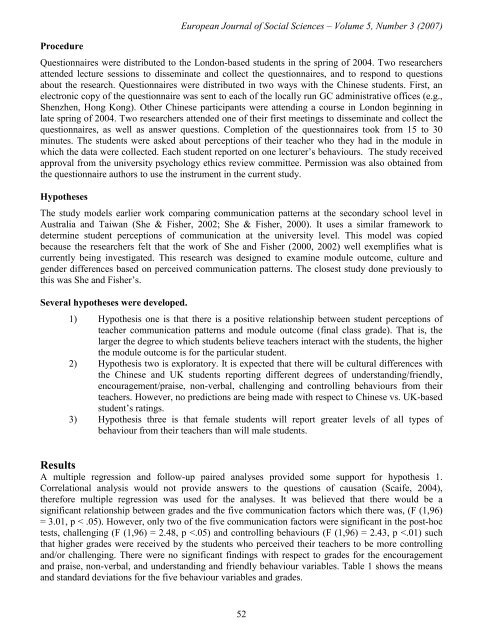european journal of social sciences issn: 1450-2267 - EuroJournals
european journal of social sciences issn: 1450-2267 - EuroJournals
european journal of social sciences issn: 1450-2267 - EuroJournals
You also want an ePaper? Increase the reach of your titles
YUMPU automatically turns print PDFs into web optimized ePapers that Google loves.
European Journal <strong>of</strong> Social Sciences – Volume 5, Number 3 (2007)<br />
Procedure<br />
Questionnaires were distributed to the London-based students in the spring <strong>of</strong> 2004. Two researchers<br />
attended lecture sessions to disseminate and collect the questionnaires, and to respond to questions<br />
about the research. Questionnaires were distributed in two ways with the Chinese students. First, an<br />
electronic copy <strong>of</strong> the questionnaire was sent to each <strong>of</strong> the locally run GC administrative <strong>of</strong>fices (e.g.,<br />
Shenzhen, Hong Kong). Other Chinese participants were attending a course in London beginning in<br />
late spring <strong>of</strong> 2004. Two researchers attended one <strong>of</strong> their first meetings to disseminate and collect the<br />
questionnaires, as well as answer questions. Completion <strong>of</strong> the questionnaires took from 15 to 30<br />
minutes. The students were asked about perceptions <strong>of</strong> their teacher who they had in the module in<br />
which the data were collected. Each student reported on one lecturer’s behaviours. The study received<br />
approval from the university psychology ethics review committee. Permission was also obtained from<br />
the questionnaire authors to use the instrument in the current study.<br />
Hypotheses<br />
The study models earlier work comparing communication patterns at the secondary school level in<br />
Australia and Taiwan (She & Fisher, 2002; She & Fisher, 2000). It uses a similar framework to<br />
determine student perceptions <strong>of</strong> communication at the university level. This model was copied<br />
because the researchers felt that the work <strong>of</strong> She and Fisher (2000, 2002) well exemplifies what is<br />
currently being investigated. This research was designed to examine module outcome, culture and<br />
gender differences based on perceived communication patterns. The closest study done previously to<br />
this was She and Fisher’s.<br />
Several hypotheses were developed.<br />
1) Hypothesis one is that there is a positive relationship between student perceptions <strong>of</strong><br />
teacher communication patterns and module outcome (final class grade). That is, the<br />
larger the degree to which students believe teachers interact with the students, the higher<br />
the module outcome is for the particular student.<br />
2) Hypothesis two is exploratory. It is expected that there will be cultural differences with<br />
the Chinese and UK students reporting different degrees <strong>of</strong> understanding/friendly,<br />
encouragement/praise, non-verbal, challenging and controlling behaviours from their<br />
teachers. However, no predictions are being made with respect to Chinese vs. UK-based<br />
student’s ratings.<br />
3) Hypothesis three is that female students will report greater levels <strong>of</strong> all types <strong>of</strong><br />
behaviour from their teachers than will male students.<br />
Results<br />
A multiple regression and follow-up paired analyses provided some support for hypothesis 1.<br />
Correlational analysis would not provide answers to the questions <strong>of</strong> causation (Scaife, 2004),<br />
therefore multiple regression was used for the analyses. It was believed that there would be a<br />
significant relationship between grades and the five communication factors which there was, (F (1,96)<br />
= 3.01, p < .05). However, only two <strong>of</strong> the five communication factors were significant in the post-hoc<br />
tests, challenging (F (1,96) = 2.48, p

















